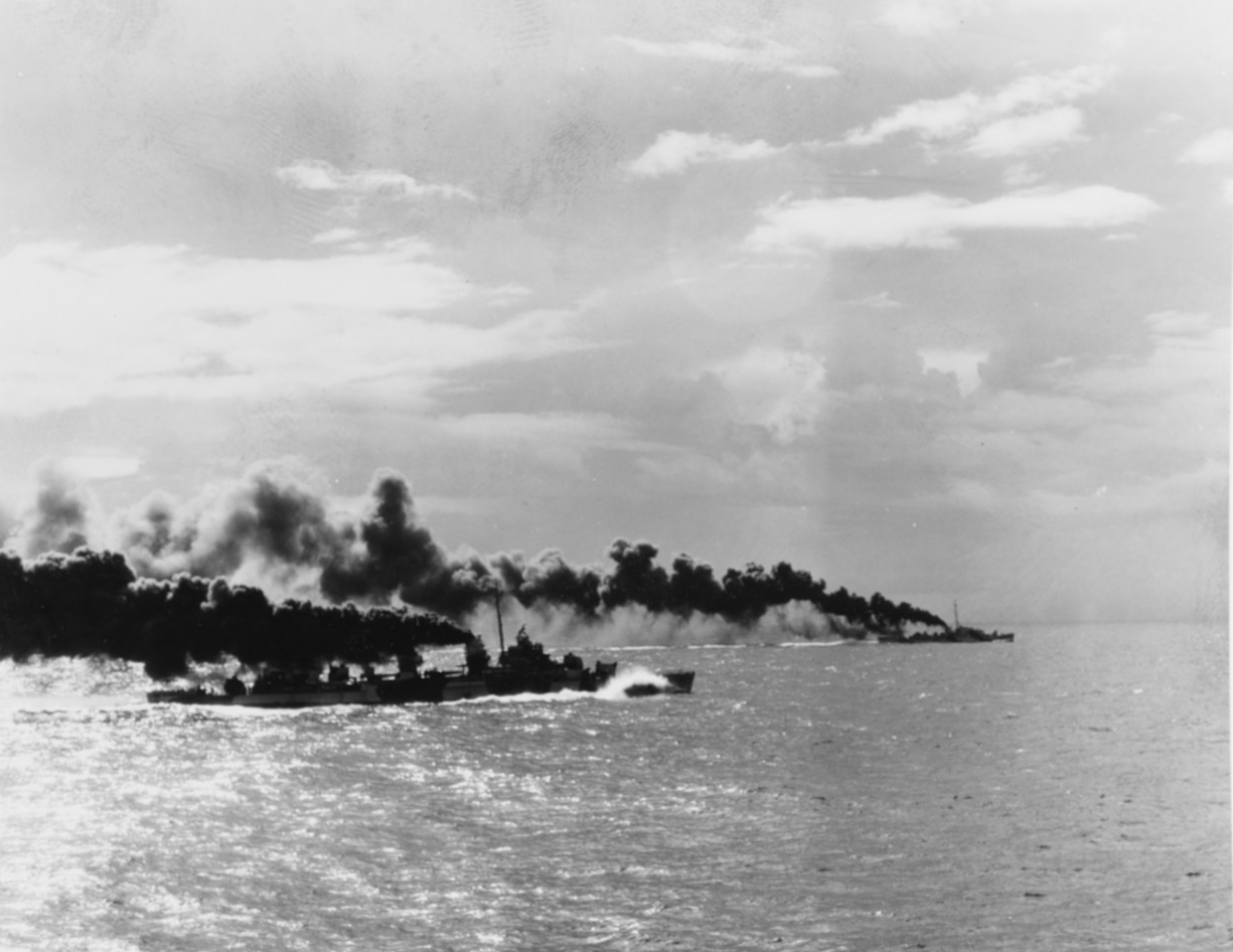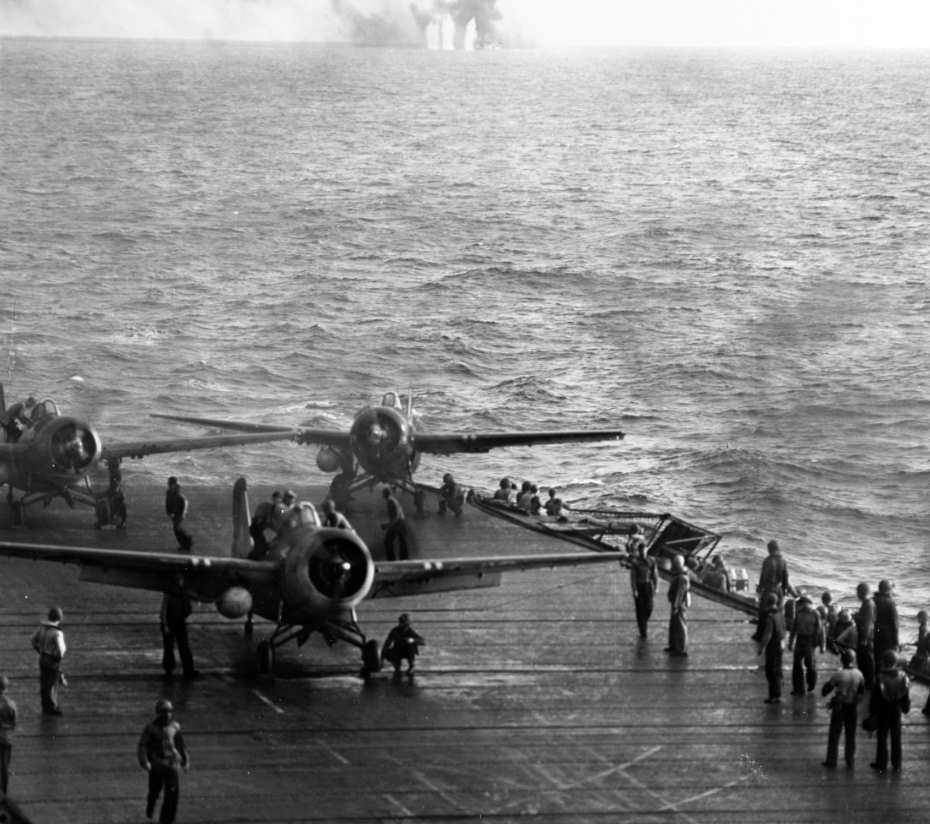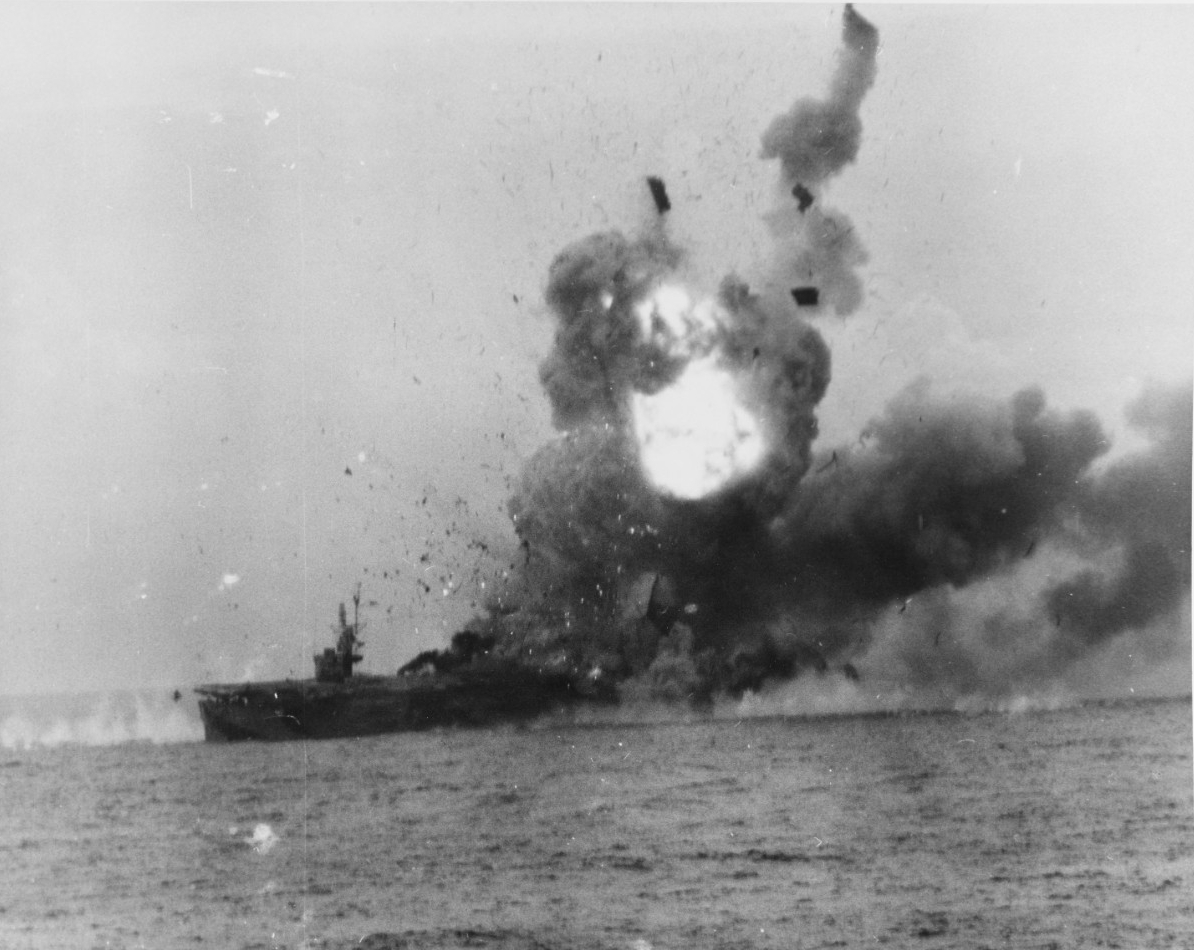H-Gram 036: Special Edition—“No Higher Honor”—The Battle off Samar, 25 October 1944
11 October 2019
“In no engagement in its entire history has the United States Navy shown more gallantry,
guts and gumption than in the two morning hours between 0730 and 0930 off Samar.”
—Rear Admiral Samuel Eliot Morison
Download a PDF of H-Gram 036 (2.5 MB).
Earlier this year, I suggested to then-CNO Admiral Richardson that the theme for this year’s Navy Birthday should be “No Higher Honor” in recognition of the 75th anniversary of the Battle of Leyte Gulf, fought in October 1944, the largest naval battle in modern naval history and a decisive U.S. Navy victory over the Imperial Japanese Navy. The phrase is from the after-action report of Lieutenant Commander Robert Copeland, skipper of the destroyer escort USS Samuel B. Roberts (DE-413), lost in a valiant sacrificial action off Samar. In lauding the calm courage of his crew in the face of near-certain death, Copeland wrote that there was “no higher honor” than the privilege to lead such a gallant crew. Admiral Richardson readily agreed. As the U.S. Navy faces increasingly capable potential adversaries in the mid-21st century, the time may well come when “courage” may once again be the critical core value in determining the outcome of battle. Those who fought in the action off Samar, and in the rest of the Battle of Leyte Gulf, set no finer example to emulate when the time comes.
Although there are many contenders for “most gallant” action in the history of the U.S. Navy, a strong case can be made that Morison’s assessment of the Battle off Samar on 25 October 1944 is correct. Despite the vast overall U.S. technological and numerical superiority during the Battle of Leyte Gulf, at a critical point in the engagement, the outcome was determined by the sheer raw courage of the commanding officers and crews of three destroyers and four destroyer escorts and the pilots and aircrewmen flying off slow escort carriers. At dawn on 25 October, none of these expected to be engaged by a much superior Japanese force of four battleships (including super-battleship Yamato,) six heavy cruisers, two light cruisers, and eleven destroyers.
Upon the commissioning of his ship, the destroyer USS Johnston (DD-557), Commander Ernest Evans stated that he would “never run from a fight,” and that anyone who did not want to go in “harm’s way” had better get off now—not one of his crew did so. However, on the morning of 25 October, the six slow (17-knot) escort carriers of Task Unit 77.4.3 (call sign “Taffy 3”) had no choice but to make a run for it (each carrier had only a 5-inch gun on the stern). Realizing that Taffy 3 was doomed as it was being overtaken by the much faster Japanese force, Evans was true to his word when, on his own initiative, he commenced a solo daylight (i.e., suicidal) torpedo attack against the Japanese in a desperate attempt to buy time for the escort carriers to get their planes off the decks and into the battle. Evans’s order to his crew was to “prepare to engage major portion of Japanese fleet,” by herself. Dodging a hail of Japanese fire, Johnston raked Kumano, the lead Japanese heavy cruiser, with accurate 5-inch gunfire, causing extensive topside damage to the heavily armored ship, and was credited with hitting Kumano with at least one torpedo that blew off her bow, taking her out of the battle. The time it took to transfer the Japanese cruiser force commander to another heavy cruiser effectively took Suzuya out of the battle, too.
As the rest of the Japanese force continued to gain, the commander of Taffy 3, Rear Admiral Clifton “Ziggy” Sprague, ordered the “Wolves” to attack, essentially ordering the destroyers Hoel (DD-533) and Heermann (DD-532) to sacrifice themselves. Although technically one of the “Little Wolves” (the destroyer escorts), the skipper of Samuel B. Roberts chose to attack, too. Copeland informed his crew that they were “going into battle against overwhelming odds, from which survival cannot be expected. We will do what damage we can.” At this point, Evans brought his by-then heavily damaged Johnston out of the temporary respite of a rain squall to support the attack of the other three escorts.
Over the next hour and a half of running battle, the Japanese commander, Vice Admiral Takeo Kurita, after ordering a “general attack,” essentially lost control of the battle as his ships raced pell-mell in an uncoordinated fashion to catch the American carriers. The U.S. escorts darted in and out of rain squalls and extensive, and very effective smokescreens. The battle degenerated into a general melee of individual ship-to-ship combat, in several instances involving U.S. destroyers versus Japanese battleships. In the chaos, both sides fired on their own ships and experienced multiple near-collisions with their own forces. With their very accurate fire-control systems, the U.S. destroyers got the better of gunnery duels. Unfortunately, the destroyers were loaded mostly with VT-fuzed anti-aircraft shells (to counter the threat they had actually been expecting), which caused carnage amongst Japanese topside anti-aircraft gunners, but did little to slow the Japanese heavy cruisers that continued to gain on the escort carriers. At one point in the battle, an attempted torpedo attack by Heermann bluffed Yamato, Kurita’s flagship, into turning away, taking agonizing (for the Japanese) minutes to get back into the fight.
Hoel was hit hard early, including accidentally by anti-aircraft shells from Johnston, but continued to fight valiantly to the end, her forward turret firing even as she went under. Eventually, Samuel B. Roberts met the same end. Although damaged, Heerman miraculously survived. As the Japanese heavy cruisers continued to gain and score hits on the U.S. escort carriers, the other three destroyer escorts, Raymond (DE-431), Dennis (DE-405), and John C. Butler (DE-339), courageously did their best to hold the charging Japanese at bay. These vessels probably survived only because the Japanese heavy cruisers were after bigger fish—they thought the escort carriers were full-size fleet carriers—and because Japanese armor-piercing shells passed clean through the thin-skinned destroyer escorts. The by-now severely damaged Johnston attacked a Japanese heavy cruiser to draw fire away from the escort carriers and was hit multiple times in return.
The gunners on the escort carriers fought hard as well, and a shell from the White Plains (CVE-66) may have hit the torpedo bank on the heavy cruiser Chokai, resulting in a crippling massive secondary explosion (the hit might also have been from a bomb). However, the fire from the Japanese cruisers continued to take a toll. Most of the escort carriers were hit, and finally the cumulative damage caused Gambier Bay (CVE-73) to fall behind to be pummeled by gunfire, including 18-inch shells from Yamato, and finally sink. As the Japanese destroyers were finally closing for a killing “Long Lance” torpedo salvo, Johnston once again intervened and spoiled the attack, resulting in the Japanese launching their torpedoes too early and thus saving the escort carriers. Johnston then came under a deluge of shellfire from all sides.
As the surface escorts fought their sacrificial delaying action, planes from Taffy 3 began to take their toll on the Japanese. The planes on the escort carriers were FM-2 Wildcats, whose role was to provide ground attack support to U.S. forces ashore, and TBM Avenger torpedo bombers, who were to provide anti-submarine defense and ground attack support. In the haste to get airborne, some of Taffy 3’s aircraft launched with insufficient fuel to make it to other carriers or the newly captured airfield on Leyte, yet they attacked anyway. Most of the aircraft did not have the appropriate weapons; some Avengers dropped depth bombs on Japanese ships, while fighters strafed battleships with guns and rockets. A number of the aircraft had no weapons at all, yet repeatedly attacked anyway, to draw fire away from those that did.
As the air attacks by Taffy 3 were underway, the four escort carriers of Taffy 1 were experiencing the first concerted and deliberate Japanese kamikaze (suicide plane) attack of the war, in conjunction with a submarine attack. Santee (CVE-29) gained the unfortunate distinction of being the first aircraft carrier hit by a kamikaze, while Suwannee (CVE-27) was hit by a kamikaze and a torpedo from one of four Japanese submarines in the area, probably I-56 (which later surfaced with an unexploded depth charge stuck to her deck). Both escort carriers survived due to extraordinary damage control. In the meantime, the six escort carriers of Taffy 2 had adequate time to launch some of their aircraft with torpedoes. As Taffy 2’s aircraft entered the fray around Taffy 3, their torpedoes had great effect on Japanese heavy cruisers with their topside anti-aircraft crews already decimated by previous shellfire, bombs, and strafing.
By 0915, the remaining Japanese cruisers (Chokai and Chikuma were already crippled, and Suzuya would later succumb to secondary explosion) and all the destroyers were finally closing in for the kill on what was left of Taffy 3. Once through Taffy 3, there was nothing between the Japanese and the U.S. transports and supply ships off General MacArthur’s beachhead on Leyte, which were actually the ordered objective of the Japanese force, on what was supposed to be a “do-or-die” mission. To the consternation of most of the Japanese force, with victory (at least temporarily) apparently in their grasp, Vice Admiral Kurita issued a general recall order. Kurita’s decision would probably be the most hotly debated of any in the entire Pacific war, and was deemed by many to be “inexplicable.” (The second most hotly debated was probably Admiral William Halsey’s decision to send all of his aircraft carriers and battleships against the Japanese carriers northeast of Luzon—which the Japanese intended as a decoy force, successfully—which left San Bernardino Strait unguarded, the U.S. invasion force with minimal Hellcat fighter cover, and allowed Kurita’s force to get as far as it did.)
With his ship’s bridge destroyed, the seriously wounded Ernest Evans fought the battered Johnston to the bitter end from a post on the stern, shouting orders down a hatch to sailors manually steering the ship. As the retreating and frustrated Japanese destroyers poured fire into Johnston, one Japanese skipper was observed to salute as the destroyer went under. Johnston’s solitary torpedo attack against an overwhelming force displayed a degree of courage in the face of certain death that the Japanese mistakenly did not believe Americans were capable of showing.
There is actually a long list of reasons for Kurita’s decision, but one that has long been under-appreciated was just how badly his ships had been hurt by the ferocity of the Taffy 3’s escorts’ attacks, and especially by the swarm of aircraft. By the time Kurita retreated through San Bernardino Strait, three of his six heavy cruisers had been sunk and another severely damaged, and almost all his ships had suffered damage from numerous shell hits, bombing, and strafing. In exchange, the Americans had lost one escort carrier (Gambier Bay), two destroyers (Johnston and Hoel), and one destroyer escort (Samuel B. Roberts), and had sustained some degree of damage to almost the entire force, along with 23 planes lost. Of the four U.S. ships that were lost, 1,785 crewmembers went down with the ship or into the water; 635 men died, a significant number due to a botched and disgracefully delayed rescue effort.
Taffy 3’s ordeal did not end with Kurita’s retreat. An hour later, the task unit came under attack by Japanese kamikaze. White Plains, Kitkun Bay (CVE-71), and Fanshaw Bay (CVE-70) were damaged by kamikaze aircraft that were near misses. Kalinin Bay (CVE-68) and St. Lo (CVE-63) were both hit, St. Lo fatally, becoming the first major ship sunk by a Japanese suicide attack.
Taffy 3 would ultimately be awarded the Presidential Unit Citation. Commander Ernest Evans would be awarded a posthumous Medal of Honor, the first Native American in the U.S. Navy to be so recognized. Many Navy Crosses were awarded. In my opinion, more Medals of Honor should have been awarded. At the time, neither the Third Fleet Commander, Admiral William Halsey, nor the Seventh Fleet Commander, Admiral Thomas Kinkaid, had interest in drawing too much attention to the Battle off Samar, as a primary reason the battle took place at all was due to one of the most monumental breakdowns in communication in U.S. Navy history, enabling Kurita to exploit the seam between areas of responsibility. There were other factors as well, but the cost of this breakdown was very high. Including the kamikaze attacks, 1,118 ships’ crew and 43 aviators from Taffy 3 and Taffy 1 were killed and another 913 were wounded. Although the Battle off Samar is now probably rightly regarded as the most gallant in U.S. Navy history, it actually cost more American lives than the disastrous loss at the Battle of Savo Island in August 1942. Victory has a high price.
As a postscript: On 14 April 1988, the third USS Samuel B. Roberts (FFG-58) struck an Iranian-laid mine in the Arabian Gulf. Upon FFG-58’s commissioning in 1986, her skipper, Paul X. Rinn, had a bronze plaque installed that listed the names of all those who served aboard the first Samuel B. Roberts when she fought so valiantly off Samar. As FFG-58 was burning and in grave danger of sinking, Sailors were seen to place their hand on the plaque, gaining inspiration and strength from the legacy of those who endured and persevered before. Post-event computer-simulation showed that FFG-58 should have gone down, yet those Sailors saved their ship in one of the most awesome displays of damage control in U.S. Navy history. At a time when the survival of the ship was very much in doubt, Rear Admiral Anthony Less, Commander Middle East Force, queried Rinn as to whether he was considering abandoning ship. Rinn responded he had absolutely no intention of doing so, finishing his defiant statement with the ship’s motto, “No Higher Honor.”
My next H-gram (hopefully next week) will provide a more comprehensive treatment of the Battle of Leyte Gulf, to include the submarine action known as the Battle of the Palawan Passage (this resulted in the loss of Vice Admiral Kurita’s flagship Atago, a heavy cruiser sunk, and another crippled); David McCampbell’s record shoot down of nine Japanese aircraft in a single sortie; the loss of the light carrier USS Princeton [CVL-23] to Japanese air attack; U.S. carrier strikes against Kurita’s force in the Sibuyan Sea (that resulted in the sinking of the super-battleship Musashi); the Battle of Surigao Strait, in which Rear Admiral Jesse Oldendorf’s Pearl Harbor survivor battleships crossed the Japanese “T,” sinking the battleships Fuso and Yamashiro; the Battle of Cape Engano, in which Admiral Halsey’s aircraft sank all four aircraft carriers in the Japanese decoy force, including Zuikaku, the last surviving Japanese carrier from the Pearl Harbor attack; as well as a more detailed treatment of the Battle off Samar and analysis of key command decisions during the battle.
(Sources include: The Defenders of Taffy 3: Analysis and Retelling of the Battle of Leyte Gulf, by Byron G. Como, Amazon Digital Services, 2018—this is a great new work with the most detailed analysis of the Battle off Samar that I have seen and sheds new light on many of the actions; Storm over Leyte: The Philippine Invasion and the Destruction of the Japanese Navy, by John Prados, New American Library, 2016—the best book by far that integrates all aspects of Intelligence (both sides) into the battle; The Little Giants: U.S. Escort Carriers Against Japan, by William T. Y’Blood. Naval Institute Press, 1987—the best book about escort carriers; Last Stand of the Tin Can Sailors: The Extraordinary World War II Story of the U.S. Navy’s Finest Hour, by James D. Hornfischer, Bantam Books, 2004—a “must read” by anyone intending to lead sailors in battle; The Battle for Leyte Gulf: The Incredible Story of World War II’s Largest Naval Battle, by C. Vann Woodward, Skyhorse Publishing, 2007—an updated re-issue of an early classic; History of United States Naval Operations in World War II, Vol. XII: Leyte Gulf, by Samuel Eliot Morison, Little, Brown and Co., 1958—still a useful foundational treatment to which all others are indebted; Anthony Tully’s website combinedfleet.com—the best source for detailed information on Japanese ships; NHHC’s Dictionary of American Naval Fighting Ships [DANFS], with recently updated detailed information on U.S. ships involved in the battle.)





